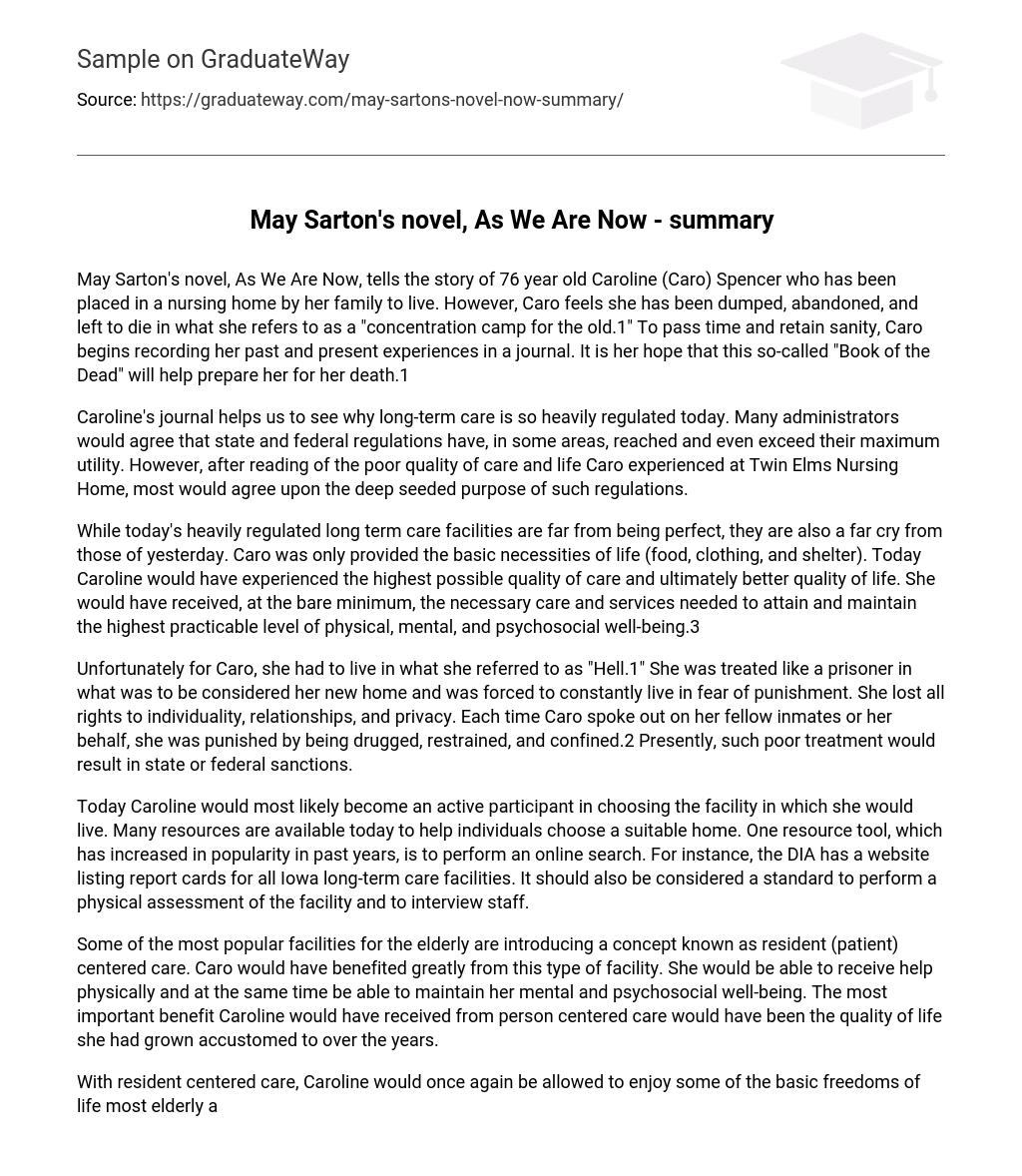May Sarton’s novel, As We Are Now, tells the story of 76 year old Caroline (Caro) Spencer who has been placed in a nursing home by her family to live. However, Caro feels she has been dumped, abandoned, and left to die in what she refers to as a “concentration camp for the old.1” To pass time and retain sanity, Caro begins recording her past and present experiences in a journal. It is her hope that this so-called “Book of the Dead” will help prepare her for her death.1
Caroline’s journal helps us to see why long-term care is so heavily regulated today. Many administrators would agree that state and federal regulations have, in some areas, reached and even exceed their maximum utility. However, after reading of the poor quality of care and life Caro experienced at Twin Elms Nursing Home, most would agree upon the deep seeded purpose of such regulations.
While today’s heavily regulated long term care facilities are far from being perfect, they are also a far cry from those of yesterday. Caro was only provided the basic necessities of life (food, clothing, and shelter). Today Caroline would have experienced the highest possible quality of care and ultimately better quality of life. She would have received, at the bare minimum, the necessary care and services needed to attain and maintain the highest practicable level of physical, mental, and psychosocial well-being.3
Unfortunately for Caro, she had to live in what she referred to as “Hell.1” She was treated like a prisoner in what was to be considered her new home and was forced to constantly live in fear of punishment. She lost all rights to individuality, relationships, and privacy. Each time Caro spoke out on her fellow inmates or her behalf, she was punished by being drugged, restrained, and confined.2 Presently, such poor treatment would result in state or federal sanctions.
Today Caroline would most likely become an active participant in choosing the facility in which she would live. Many resources are available today to help individuals choose a suitable home. One resource tool, which has increased in popularity in past years, is to perform an online search. For instance, the DIA has a website listing report cards for all Iowa long-term care facilities. It should also be considered a standard to perform a physical assessment of the facility and to interview staff.
Some of the most popular facilities for the elderly are introducing a concept known as resident (patient) centered care. Caro would have benefited greatly from this type of facility. She would be able to receive help physically and at the same time be able to maintain her mental and psychosocial well-being. The most important benefit Caroline would have received from person centered care would have been the quality of life she had grown accustomed to over the years.
With resident centered care, Caroline would once again be allowed to enjoy some of the basic freedoms of life most elderly are forced to give up when they enter into a long-term care facility. This increased quality of life would be a direct reflection of the facilities attitude toward supporting individual dignity, allowing individual choices, and meeting individual needs. Resident centered care allows individuals to make daily living choices like when to get up and go to bed, when to bath, what to do, and when and what to eat. With resident centered care, Caro could make the long-term care facility a home and not just a place to end her life in.
If Caroline were to increase her physical well-being in a nursing facility, she would be an excellent candidate for a number of services such as home health care, adult day care, and independent living. It is very possible that Caroline would have been able to keep her own home and have daily assistance with her housekeeping, laundry, and dietary needs.2 For instance, many physically frail individuals take advantage of the local meals on wheels program which provides individuals at least one meal a day for a small fee.
In conclusion, while the past of long-term care was unfortunate, the present is looking up. With regulations guiding quality of care, the conception of resident centered care, and the inception of alternative personal care options, individuals like May Sarton’s Caroline Spencer can be assured of the highest practicable quality of life when faced with the long-term care decision.
References
1 Sarton, May. As We Are Now. New York: W. W. Norton & Company, 1973.
2 Selsor, Selena. Personal Interview. February 12, 2004.
3 Gordon, George K. and Leslie A. Grant, and Ruth Stryker. Creative Long-Term Care Administration, 4th Edition. Springfield, IL: Charles C. Thomas, 2003.





